Many novice builders ask themselves the question "foundation, what is it and what is it for at all?" It is not difficult to figure out what this structure is, since it is clear from the name that it is a thin layer of material that covers the foundation pit before laying the foundation (often this layer is also called a pillow). However, it is worth deciding why you need to do this, and whether it is necessary to perform a footing when building a house or a bath.
Why do you need to mount a footing
The foundation performs a number of useful functions, namely:
- Creates a waterproofing layer. Due to this, in the process of pouring the foundation, the grout will not flow. In addition, moisture in the screed will be evenly distributed and the base will not crack when it dries.
- Creates a flat surface for a rough concrete base. Due to this, the consumption of cement-sand mortar is reduced.
- Protects the foundation from groundwater.
- Redistributes the pressure exerted by the soil and ground parts of the structure.
- Allows to produce better quality reinforcement.
- Eliminates the shrinkage of the building.
In addition, such a shock-absorbing layer significantly improves the strength and durability of the entire structure. The foundation, laid on the concrete, “survives” the winter easier.
From all of the above, it becomes obvious what a foundation is needed for, so let's move on to the varieties of these slabs.
Types of simple footings
There are several types of foundation slab:
Crushed stone
Such "preparation" is considered more economical, since crushed stone is cheaper than cement composition. The crushed stone layer must be at least 20 cm high. In the process of laying the footing, a thorough ramming is a prerequisite (preferably with the use of vibratory ramming equipment).
If it speaks about the shortcomings of "preparation", then the technology of laying crushed stone under the foundation is not considered reliable. The fact is that such a substrate is not rigid enough, therefore, further work on the installation of the foundation on such a basis will not be performed at the highest level. However, if you do not plan to build a multi-storey building, then such a foundation will be quite enough for a utility block or a bath.
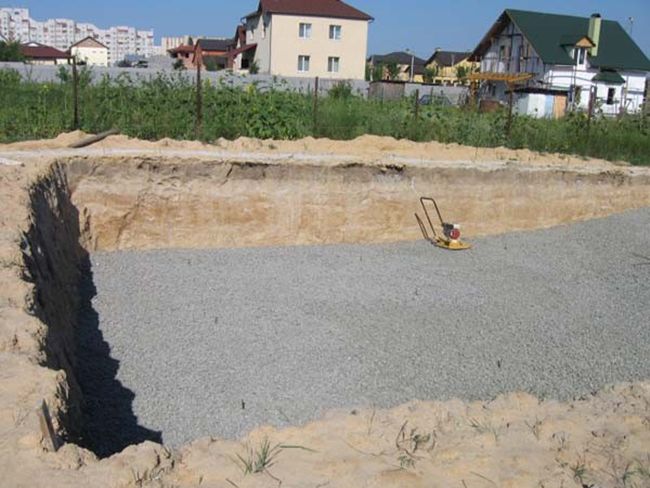
To install the simplest base, follow these steps:
- Prepare your work surface and place rubble on top of it.
- Smooth it out with shovels.
- Tamp and compact the pad over the entire surface.
- Apply a layer of bitumen to the obtained foundation to obtain good waterproofing. If you want to save money, you can use roofing material or polyethylene instead of bitumen, but these materials have lower waterproofing performance.
Sandy
Sand "preparation" is the best way to redistribute the loads on the foundation. It is recommended to lay such cushions in autumn and spring when the soil is undergoing changes. Due to the underlying layer of sand, the lower part of the foundation will be located above the groundwater level, so that the monolith will not suffer from the harmful effects of moisture. That is why most often sandy footings are installed on areas with problem soil.
To install such a layer, you must:
- Remove the soil layer.
- Instead, fill in river sand with a fraction of at least 1.5 cm.
- Using a building level, level the pillow around the entire perimeter.
- Tamp the "preparation".
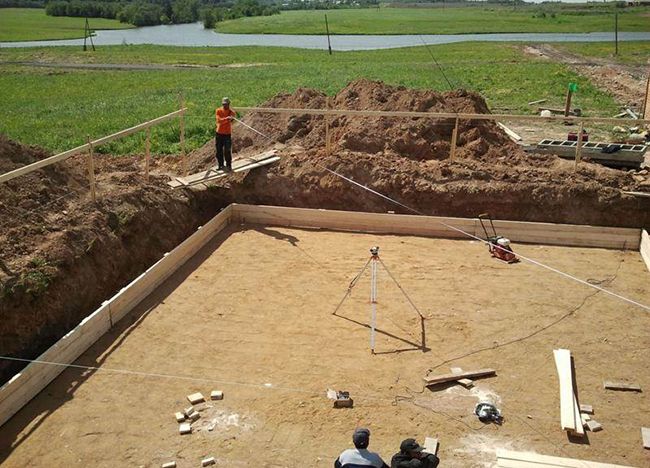
Helpful! To determine the required thickness of the foundation, as well as to select the desired type of interlayer, it is necessary to take into account: the type of soil, the presence of surrounding buildings, seismicity and acting loads. Detailed requirements and calculations are set out in SNiP 2.02.01-83, as well as in SP 50-101-2004 and SP 63.13330.2012.
Sandy and crushed stone pillows are not suitable for all buildings and are not very durable. If you want to make the most reliable base for a residential building, then, of course, you should give preference to a concrete slab.
Concrete pad
The construction of a footing of this type requires large financial investments, but it is precisely such a basis that is best suited for slab and strip foundation... The fact is that during the installation of such foundations, a heavy reinforcing frame made of rigid steel rods is installed, which requires a more solid foundation.
Before starting the installation of the base, you must consider a few tips:
- For the installation of the foundation, "thin concrete" of classes from B 3.5 to B 7.5 (M 50, 75, 100) is used. It makes no sense to use more durable cement, moreover, it will cost many times more.
- To obtain a solid "preparation", it is enough to lay a concrete pad 10 cm thick (provided that the site is not dominated by groundwater).
- Before laying the concrete mixture, it is necessary to pour a thin layer of sand or crushed stone onto the bottom of the excavation or trench.
- If the reinforcing frame is not used when installing the concrete cushion, then the optimal base thickness will be 15-20 cm.

- Thanks to the reinforcement of the footing, the ground part of the structure will be located on solid foundation... For the armopoyas, metal rods with a cross section of 8 mm are used. The rods are installed vertically and should protrude above the surface by approximately 25-30 cm. In this case, the thickness of the "preparation" can be reduced by 6-10 cm.
Installation of foundation
Let's say you are planning to build a house on an area with fairly loose soil and an elevated water table. To do this, follow these steps:
- Determine the highest point of groundwater - "preparation" is best done up to this level. Some mount the "preparation" in such a way that it protrudes beyond underground structure by 10 cm.
- Level and compact the soil.
- Pour coarse sand to the bottom of the pit, spread it over the surface and compact it thoroughly. For the best effect, you can also lay a layer of rubble.
- Lay roofing material or polyethylene on top of the sand.
- Lay the reinforcement cage with 60 x 60 cm cells.
- Install the guides, it will be more convenient to level the liquid mixture along them.
![]()
- Mix cement, crushed stone, sand and water until a homogeneous thick mass is obtained.
- Pour in concrete solution and level it over the lighthouses using the rule.
- After the base has solidified, treat the surface with bitumen.
Helpful! In order not to use expensive equipment for drilling after the monolith has solidified, it is recommended to think over the holes for communications at the stage of laying raw concrete.
In custody
Depending on the type of building, sand, crushed stone or concrete "preparation" can be laid. Such a pillow will give the entire structure additional strength and protect the foundation from groundwater.
Laying the foundation is one of the most important components construction works... Not the least important in this process is the device of a special foundation, which must be located under a solid foundation. The quality of its execution determines the stability and durability of the structure. Before carrying out work, it is necessary to determine what density of the concrete or crushed stone layer is needed for the construction of a particular building.
The foundation is a layer concrete mortarwhich must be prepared for an economical, convenient laying of the main foundation. This thin layer is poured to the bulk (for example, during the construction of the base using concrete slabs).
Purpose and thickness
A preparatory concrete or crushed stone base is made using different methods, means and building materials... But with any device, its purpose will remain unchanged - it is to prepare and level the surface. Due to this, the main concrete pouring is consumed more economically due to uniform laying, which does not require additional costs of the mixture for unevenness and deepening in the soil. Concrete and crushed stone footing, which is required for construction work, is used in the following cases:
- Surface preparation for ease of installation of structural parts. On a leveled site, it is much easier to make markings, reinforcement cage, etc. Obviously, on loose soil, these works are more difficult to carry out.
- Waterproofing. Thin concrete bases are also necessary in order to retain moisture from the poured solution. Cracks appear on the frozen slab. They often appear due to the fact that the liquid is unevenly distributed in the structure of the cement.
- Protection of the foundation from groundwater. If the layer is laid under the slab base, groundwater can enter the pit. In these cases, the foundation absorbs some of the liquid, thereby preserving the load-bearing layer on which the building rests.
In addition, the presence of shock absorption increases the strength of the structure due to the fact that the base is better preserved. As for the thickness of the foundation monolith, it will depend directly on the dimensions and weight of the structure. On average, this indicator is in the range of 0.15-1 meter.
 Preparation can be made of concrete, bulk or film materials.
Preparation can be made of concrete, bulk or film materials. Preparation types
Before starting the main work, it is necessary to prepare. The complex of works includes the following three stages:
- performing calculations;
- alignment of the site;
- surface preparation before laying the base.
First preparatory stage assumes careful calculations and work with documentation. Then you need to clear the site. From the territory you will need to remove garbage, cut down and uproot trees, dig up shrubs and other plants. The next step involves creating a "cushion" on the surface, which will be located under the foundation of the future building. For this, the following building materials are used:
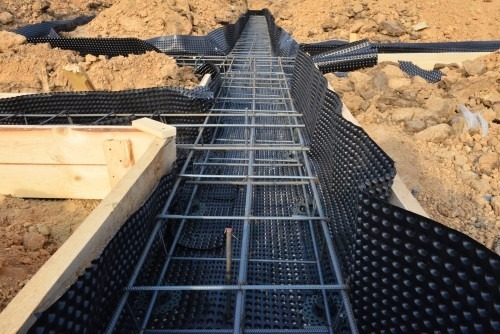
Preparation device (stages of work)
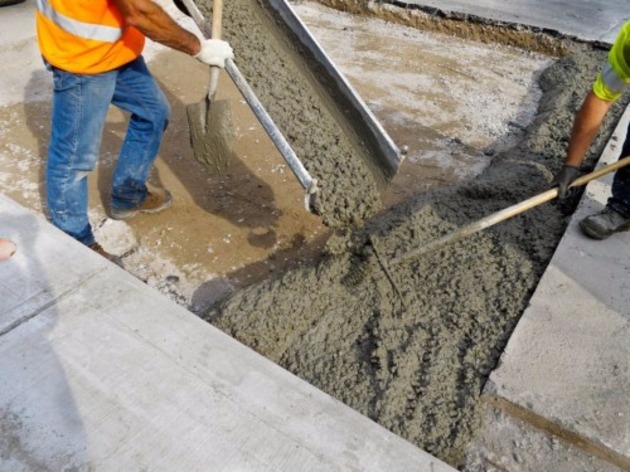 First, you need to clear the surface of the soil and make a pit. Competent preparation of the deepening involves carrying out a number of works that are aimed at bringing the soil to the desired state. In other words, the soil must withstand the strong loads specified in the design. It is necessary that after completing the laying of the base, the soil tightly wraps around the foundation from below. First, it is worth forming a pit, cleaning its bottom with a bulldozer, and then carefully compacting the base. In addition, during the compaction of the pit, the soil should be moistened or dried. Most often, trenches are dug by hand. In addition, the builders sight the surface of the base itself, expose the corners of the walls using pegs. After the pit has been dug, the specialists proceed to the following stages of construction:
First, you need to clear the surface of the soil and make a pit. Competent preparation of the deepening involves carrying out a number of works that are aimed at bringing the soil to the desired state. In other words, the soil must withstand the strong loads specified in the design. It is necessary that after completing the laying of the base, the soil tightly wraps around the foundation from below. First, it is worth forming a pit, cleaning its bottom with a bulldozer, and then carefully compacting the base. In addition, during the compaction of the pit, the soil should be moistened or dried. Most often, trenches are dug by hand. In addition, the builders sight the surface of the base itself, expose the corners of the walls using pegs. After the pit has been dug, the specialists proceed to the following stages of construction:
- marking of the construction site for the foundation;
- alignment of the site;
- preparation of the required amount of gravel (layer - ten centimeters);
- tamping the pillow with a vibration device;
- installation of formwork (its height depends on the concrete layer of the layer;
- pouring mortar to the top of the formwork;
- pillow reinforcement (cross-section of rods - at least eight millimeters);
- ramming cement mix vibrating plate;
- installation of a reinforcing cage, which allows you to fasten the crushed stone pillow to the base (they should protrude about twenty to thirty centimeters above the poured concrete).
A reinforced frame can be installed in concrete, but you can do without this material. In practice, there are almost no differences between the two options. The only difference is that a pillow created without reinforcement is limited in size.
In fact, it is very easy to understand what a foundation is. Here even the name speaks for itself - it is a layer of thin concrete, which is prepared for comfortable and economical pouring of the bulk of the mixture. In fact, this layer is placed under the main concrete layer when installing slab foundations, eg.
But why exactly this needs to be done (and whether it is necessary at all) is worth understanding in detail. In addition, it will be useful to consider what the installation instructions for such a base are.
Let's start with the most important thing.
Purpose of the foundation

It is worth noting that the preparatory layer can be done different ways and materials can be applied differently. However, the meaning, the purpose of this work remains the same ().
| Objective | What does it give in practice |
| Leveling the rough base. | This allows you to reduce the amount of the main mixture when pouring, that is, to save a little. This happens due to the fact that the concrete layer will lay down evenly and there will be no mortar drifts into incomprehensible pits. |
| Preparation of the plane for easy installation of various structural elements. | Convenience lies in the fact that on a flat area you can make markings much faster, assemble a frame from reinforcement and install beacons, for example. Agree that this is not so easy to do on loose soil with pits and bumps. |
| Creation of a waterproofing layer. | This means that due to the presence of a foundation, the moisture from the solution will not disappear from the solution when pouring the bulk of the mixture with your own hands. Accordingly, cracks will not appear on the finished slab or screed, which are usually formed due to the uneven distribution of moisture within the structure of the working area. |
| Creation of protection from groundwater. | That is, if this layer is done under a slab-type foundation and groundwater often appears at the bottom of the pit, then in this case it is required to take moisture from the foundation and prevent it from passing further into the main bearing layer of concrete. |

In addition, the presence of such a cushion layer improves the strength characteristics of the entire structure as a whole. At least due to the fact that the main layer dries up and gains strength better, better.
Please note that the construction of the concrete means the use of inexpensive concrete mix. As a rule, "skinny" concrete B3.5-B7.5 is used. That is, it turns out that due to the preparation of such a layer, the total cost of the project is reduced, since a significant volume of the total cubic capacity is filled with a composition with a lower cost.
So, why such work is needed is probably clear. Now let's see how this is done.
Methods for setting up a footing
Before we get started, it's worth noting that footing is, first of all, a very desirable measure, but not always required ().
That is, to put it simply, if you have a small-scale project and the rough base consists of an old screed and there is no trace of loose soil or uneven relief, then it is simply inappropriate to perform such work.
So objectively assess the situation - you shouldn't waste money where such additional work will not affect the final quality in any way.
Let's go back to the options for such a layer. As an illustrative example, let's take the preparation for pouring a slab foundation.
Installation of the simplest foundation
For work we need this:
- Crushed stone.
- Ramming device. It is easiest to make it from wood or metal.
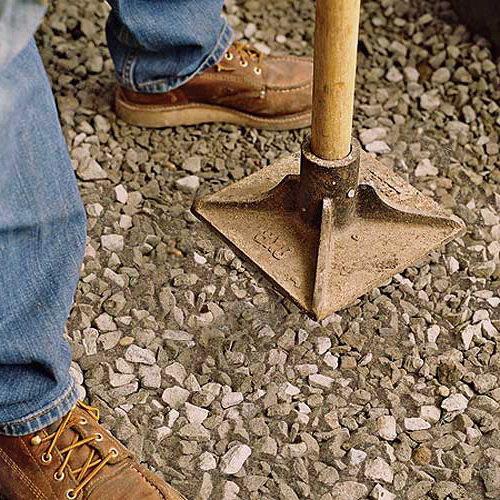
- Liquid bitumen.
- Good and durable shovels.
You can start.
- Pours out onto the working area required amount crushed granite. As a rule, the material is dumped from the dump truck and the result is a large pile of rubble.
- With the help of shovels, stones are evenly distributed over the entire surface.
- A ramming device is taken and crushed stone is compacted over the entire area.
- A layer of bitumen is applied to the resulting plane.
Advice: you can save and use not bitumen, but more or less durable roofing material or even a film. In any case, this will not give a particularly good waterproofing in the future, but at least these materials will allow concrete to solidify with high quality (without moisture loss).
In general, the simplest version of the foundation has been implemented.
Now let's look at how to do this as correctly as possible.
Construction of capital foundations
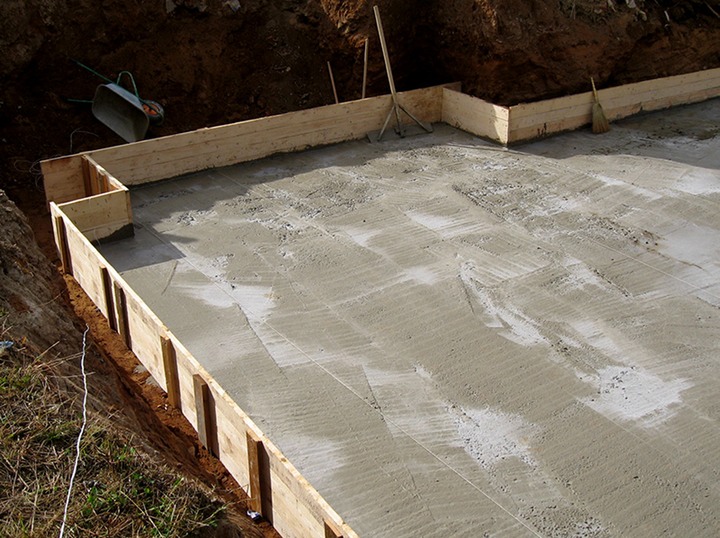
So, we have a working area with loose soil and a risk of groundwater.
- We determine the highest point of groundwater - the foundation will have to be done just up to this level (well, in any case, it is desirable to do just that).
- With the help of shovels, we try to level, plan the soil.
- We fill up sand on the bottom of the pit and evenly distribute it over the surface, and then ram it.
- We put a film or roofing material on top of the sand.
- From thin reinforcement we make a kind of "cage" with a cell size of about 60 by 60 cm.
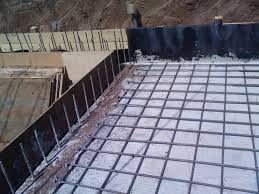
- If desired, set the guide lines - beacons. It is convenient to stretch the mixture along them in order to get the most even surface in the end.
- Stir cement, sand, gravel and water - a homogeneous thick mass should be obtained.
- Fill the solution and use the rule to distribute it over the entire area.
- After the solution has dried, it must be treated with bitumen and, in fact, the footing device is completed on this.
Advice: in almost every such structure, holes are then made for communications. As a rule, for this, cutting of reinforced concrete with diamond wheels with a grinder is used, or simply drilling with a standard perforator. But it is possible to significantly facilitate and speed up the work if such holes are “laid” in advance - in the still damp concrete.
But even if you simply simply forgot about such moments, and not only the lining layer, but also the main slab is already poured, then you should not despair, because you can always use such a service as diamond drilling of holes in concrete with powerful industrial equipment.
Basically that's all. The technology review is over. Let's summarize.
Conclusion
We have figured out in detail what this is - a foundation and how it is done. We also got acquainted with the cases in which it should be done and in which not. We hope that all the information provided will be useful to you in practice ().
Well, if you want to know more, then be sure to watch the additional video in this article - there are a lot of interesting and useful things in this video!



